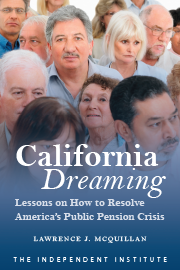Inspired by California’s lower than average electricity use since the 1970s, the Natural Resources Defense Council is recommending that “states and utilities outside California” follow the Golden State’s lead.
Indeed, the infatuation with California has gone global. The World Bank, in its 2010 Development and Climate Change Report, pointed to California as “a U.S. leader in energy efficiency” and a model for the rest of the world.
The only problem with such views is that they are based on the misguided notion that California’s energy efficiency standards on appliances, homes, and commercial buildings are largely responsible for the state’s lower than average electricity use. In fact, research shows that factors other than regulation should get the credit.
In a new study released by the nonpartisan National Bureau of Economic Research (NBER), economist Arik Levinson of Georgetown University analyzed 46 years of statistical data to determine which factors account for California’s lower per capita residential electricity consumption compared to the rest of the country.
He concluded: “Even without California’s regulations, its residential electricity consumption per capita would have been falling steadily relative to other U.S. states for the past 40 years.”
Here’s why.
Shifting population: Fifteen percent of California’s comparatively lower electricity consumption, the NBER research found, was due to population shifts. Millions of Americans have migrated in recent decades from the North to the South and Southwest, where homes on average are larger and temperatures much hotter. This has resulted in increased electricity use in southern states for air conditioning.
Climate and income: Twenty percent of California’s lower per capita electricity consumption was attributed to a combination of rising incomes nationally and California’s more moderate climate. As incomes rise, people typically spend more money on heating and cooling. The study showed that increased electricity consumption due to rising incomes has been greater in states with hotter and colder climates than temperate California.
Household size: Finally, some 61 percent of California’s comparatively lower electricity consumption was attributed to changing demographics, especially household size.
The size of the average household in California has decreased less than in other states, the study found, meaning that a significant amount of electricity “conservation” in California is simply a function of more people sharing the same appliances and living space than in other states.
The NBER research found that only a small fraction of California’s energy-efficiency advantage could be attributed to stricter regulations. Indeed, Professor Levinson concluded that California’s experience provides “no lessons for other states or countries considering adopting or tightening their energy efficiency standards” because California’s “conservation” is due to geography and demographic factors that are not replicable in other locations.
Despite this, regulators press on. In California, stricter energy efficiency standards for buildings are set to go into effect in January 2014.
Dr. Robert Weisenmiller, chair of the California Energy Commission, boasted, “Once again, California is setting the standard for energy efficiency, keeping the state’s dominance as the most energy efficient state per capita.”
What Weisenmiller doesn’t acknowledge (or perhaps even understand) is that the dramatic difference in California’s electricity use, relative to other states, would have occurred without the standards and the underlying government bureaucracy.
Energy regulators in other states and around the world are wrong to point to California’s lower per-capita use of electricity as proof that stricter energy efficiency standards are the answer. They would be compounding the wrong to copy them.
As Levinson aptly said in an interview, energy efficiency standards “are a very poor way of targeting the problems associated with energy use.”
Policy makers and the public have a right to be skeptical of tighter, more complicated, and more burdensome regulations.









